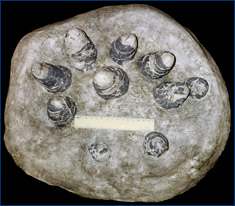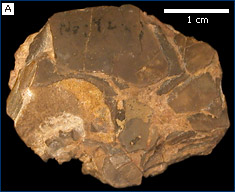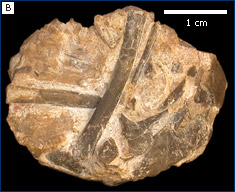 |
|
|
V. Paleobiology and eggs |
Paleobiology is the study of the origin, structure, physiology, behavior, ecology, and evolution of extinct organisms, and fossil eggs and eggshell can reveal useful information about the paleobiology of the animals that laid the eggs. Nest structures, whole eggs with embryos, associated skeletons, and the encasing sediments can all aid in answering paleobiological questions. The preservation of nests and associated bones (especially embryos) are far less common in the fossil record than eggshell fragments, but each discovery of eggs with associated material sheds more and more light on the biology of extinct animals.
Much of the scientific literature about fossil eggshell tends to focus on dinosaurs. This is largely due to the popular appeal of dinosaurs, as well as the preservation potential of dinosaur eggs. Dinosaur nests and nesting grounds have been discovered in floodplain sediments, which commonly preserve fossils from terrestrial environments. Spectacular dinosaur nesting localities have been found in Montana, Argentina, China, India, France, Spain, and Mongolia, advancing the knowledge of the reproduction and nesting habits of several dinosaur species.
Paleobiological information from eggshell structure
The surface of an egg is not perfectly smooth. Often fossil eggshell is textured
with ridges or nodes, and all eggshell is perforated by a network of pores which
allow gases (oxygen, water vapor, and carbon dioxide) to be exchanged between
the embryo and the environment outside the egg. These features can provide information
about both nesting behavior and climate. For example, some researchers speculate
that a surface texture of nodes and ridges can help in preventing plant debris
(often used to cover the eggs) from plugging the pores, thereby protecting embryos
from suffocation. Porosity and water vapor conductance rate (related to the exchange
of gases between the embryo and environment and thus eggshell porosity) have
also been related to amniote nesting behavior and may indicate whether eggs were
buried in sediment or left exposed. Lower porosity and water vapor conductance
have been associated with a more bird-like open (uncovered)
incubation of
eggs, while high porosity and conductance rates have been associated with the
non-avian reptile-like behavior of burying egg clutches. Low porosity has also been attributed
to arid climates, as minimal water loss from an egg would be imperative for embryo
survival.
Paleobiological information from nests (Fig. 1)
| Click any image on this page to see an enlargement. | |
 Figure 1. Cast of a Troodon nest from the Late Cretaceous of Montana. Note the circular arrangement of eggs. Specimen UCM 239, photograph CO96.18. |
Scientists have made inferences about the reproductive physiology and egg-laying strategies of dinosaurs by looking at the arrangement and orientation of eggs in a nest. The arrangement of eggs has been used to infer the number of functioning ovaries in the egg-layer. For example, eggs that appear to be paired in a nest suggest that the egg-layer had two functioning ovaries, in which two eggs were formed at the same time and then laid one after the other — perhaps followed by a period of inactivity before the next pair was laid. Unlike non-avian reptiles that possess two ovaries and oviducts and lay eggs all at one time, extant birds have only one functioning ovary (the other one was apparently lost as an adaptation to reduce body weight for flight) and lay one egg at 24 hour or greater intervals. Both ovaries and oviducts may have functioned simultaneously while forming only one egg at a time in their extinct theropod relatives, a condition not present in any extant amniotes. This shows how data regarding dinosaur reproductive physiology can shed light on the relatedness of certain dinosaur groups to birds or crocodiles (the two closest extant relatives of the non-avian dinosaurs).
Patterns of eggshell preservation in a nest have also been linked to nesting behavior and parental care. Lots of broken eggshell in a nest has been interpreted as evidence that hatchling dinosaurs remained in the nest for extended periods; the eggshell may be broken because it was trampled by nest-bound hatchlings. That the hatchlings spent significant time in the nest after hatching implies that adults of at least some dinosaur species provided a degree of parental care for their young.
Additionally, adult specimens have been found in nest structures along with hatchlings and juveniles of the same species. The preservation of adults and juveniles of the same species together provides strong evidence of parenting behavior. Spectacular examples of this have been found in Montana and Mongolia (among other places; see "Additional readings").
Paleobiological information from embryos (Fig. 2)
Eggs that are found with their associated embryos provide the only opportunity
to absolutely determine which eggshell type was characteristic of a specific clade of
extinct animal. Sometimes the embryonic material may be identifiable to a particular
species (especially if juvenile and adult skeletons are also in the area), and
sometimes nothing more may be known than a broad taxonomic group — like "Sauropoda" or "Pterosauria." Unfortunately, embryonic remains are very
rare in the fossil record — the bones are small, fragile, usually incompletely ossified,
and thus easily destroyed. Eggs and embryonic bones are only preserved under
exceptional depositional conditions; fossil embryos have been reported from dinosaurs,
turtles, birds, and pterosaurs.
 |
 |
|
Figure 2. Fossil bird egg from the Eocene of Colorado with embryonic bones. A. smooth shell with (B) embryonic bones preserved inside the eggshell layer. Specimen UCM 17. |
||
The study of embryonic and juvenile remains has proven useful in understanding the ontogeny (development and growth) of extinct animals. Characteristics such as the size of the embryo relative to adult body size and the degree to which the embryo's bones are developed can be compared to embryos of extant animals. This technique has been used when comparing non-avian dinosaurs and birds. The degree of ossification (bone formation) at hatching has also been used to interpret dinosaur parental behavior — if a hatchling had poorly developed bones that prevented it from immediately leaving the nest, the adults would have had to provide for the newly hatched young.
Paleobiological information from pathological eggs (Fig. 3)
It is not easy to deduce the reproductive habits of extinct animals that produced pathological shell. Pathological eggs preserved in situ (undisturbed and in original position) in a nest are rare, and have never been found with skeletal remains. It is inferred that a multilayered eggshell is fatal to embryos because the pores do not align between the shell units and embryos would asphyxiate. Before multilayered eggs were found in extant avian eggshell, pathological eggs were interpreted to represent reptile-like reproduction. However, this is no longer accepted. Pathological eggs are most common in turtles, but they likely do not provide an appropriate analog to dinosaur reproduction due to differences in evolutionary lineages.
Paleobiological information from preservation
Although useful paleobiological information can be gleaned from eggs and eggshell,
the preservation of eggshell is relatively uncommon in most deposits, and the
preservation of nests and embryos is even rarer. Nevertheless, information about
the paleobiology and paleoecology of extinct animals can be gained by studying
the conditions under which these fossils were preserved. Whether eggshell has
been transported to the site of preservation or is in situ plays an important
role in the amount of information available from a deposit. Accumulations of
eggshell fragments near a nesting area might have been derived from multiple
eggs originally laid in the nests. In situ remains reveal the preferred nesting environments of extinct animals. Alternatively, accumulations of eggshells
may have been washed in by rivers or during flooding events, may have belonged
to other organisms that shared the nesting area, or may even have been the remains
of food eaten by recently hatched nestlings. Although transported eggshell cannot
provide as much paleobiological information as in situ eggshell, it offers
information on the ancient river systems, such as stream power and geochemical
conditions.
Cases of exceptional preservation of fossil eggs are particularly informative. Organic matter usually decays during fossilization, but preservation of organic matter within eggshell increases our understanding of the microstructure (internal morphology) and taphonomy of fossil eggshell. Preservation of tissues inside eggs is also informative. One dinosaur nesting site in Argentina has produced fossil egg remains with embryonic skin impressions as well as shell membrane. In other rare cases, eggs have been found preserved in situ within the body cavities of dinosaurs and turtles, providing unique opportunities to study reproductive physiology.
Paleobiological information from depositional environment
The nature of the depositional environments where eggs are found can also reveal
information about the breeding behavior of nesting animals. Discoveries of multiple
layers of nests within the same area have led researchers to suspect that some
localities have been used by the same species of animal over multiple breeding
seasons. This not only indicates gregarious behavior (animals tending to form
groups) by some species, but also suggests "site fidelity," returning
to the same nesting sites over multiple years. However, it should be noted
that these terms can have a different meaning when applied to the fossil record
than when applied to the ecology of modern taxa. In the latter, the same
animals typically return to a nesting site within a short time interval (nesting
season or years). In the fossil record, egg-bearing horizons may be separated
by several meters of sediment that might represent hundreds to thousands of years.
Additionally, the nature of the sediments in which eggs and eggshells are deposited can reflect environmental conditions in which extinct animals lived. The presence of caliches indicates wet and dry seasons, and other evaporite minerals may indicate that eggs were deposited in arid or semi-arid environments. Paleosols (ancient soils) containing fossil eggshell can provide paleoenvironmental information such as temperature, precipitation, hydrological conditions, etc. Other fossils associated with eggshell may reveal other animals that shared ancient environments with the egg-layers.
Additional readings
Coria, R.A., and L.M. Chiappe. 2007. Embryonic skin from Late Cretaceous sauropods (Dinosauria) of Auca Mahuevo, Patagonia, Argentina. Journal of Paleontology 81(6):1528-1532.
Grellet-Tinner, G., L. Chiappe, M. Norell, and D. Bottjer. 2006. Dinosaur eggs and nesting behaviors: A paleobiological investigation. Palaeogeography, Palaeoclimatology, Palaeoecology 232:294-321.
Hirsch, K.F. 1994. The fossil record of vertebrate eggs. Pp. 269-294 in S.K. Donovan (ed.), The Palaeobiology of Trace Fossils. John Wiley and Sons.
Horner, J.R. 1982. Evidence of colonial nesting and "site fidelity" among ornithischian dinosaurs. Nature 297(5868):675-676.
Horner, J.R. 1984. The nesting behavior of dinosaurs. Scientific American 250(4):130-137.
Horner, J.R. 2000. Dinosaur reproduction and parenting. Annual Review of Earth and Planetary Sciences 28:19-45.
Horner, J.R., and D.B. Weishampel. 1988. A comparative embryological study of two ornithischian dinosaurs. Nature 332:256-257.
Jackson, F.D., and D.J. Varricchio. 2003. Abnormal, multilayered eggshell in birds: Implications for dinosaur reproductive anatomy. Journal of Vertebrate Paleontology 23(3):699-702.
Jackson, F.D., D.J. Varricchio, R.A. Jackson, B. Vila, and L.M. Chiappe. 2008. Comparison of water vapor conductance in a titanosaur egg from the Upper Cretaceous of Argentina and a Megaloolithus siruguei egg from Spain. Paleobiology 34(2):229-246.
Meng, Q., J. Liu, D.J. Varricchio, T. Huang, and C. Gao. 2004. Parental care in an ornithischian dinosaur. Nature 431:145-146.
Paik, I.S., M. Huh, and H.J. Kim. 2004. Dinosaur egg-bearing deposits (Upper Cretaceous) of Boseong, Korea: Occurrence, palaeoenvironments, taphonomy, and preservation. Palaeogeography, Palaeoclimatolgy, and Palaeoecology 205:155-168.
Sato, T., Y.-n. Cheng, X.-c. Wu, D.K. Zelenitsky, and Y.-f. Hsiao. 2005. A pair of shelled eggs inside a female dinosaur. Science 308:375.
Schweitzer, M.H., L. Chiappe. A.C. Garrido, J.M. Lowenstein, and S.H. Pincus. 2005. Molecular preservation in Late Cretaceous sauropod dinosaur eggshells. Proceedings of the Royal Society B 272(1565):775-784.
Varricchio, D.J., F. Jackson, J.J. Borkowski, and J.R. Horner. 1997. Nest and egg clutches of the dinosaur Troodon formosus and the evolution of avian reproductive traits. Nature 385:247-250.
Varricchio, D.J., A.J. Martin, and Y. Katsura. 2006. First trace and body fossil evidence of a burrowing, denning dinosaur. Proceedings of the Royal Society B 274(1616):1361-1368.
 |
|
 |
|
 |
|
 |
| Fossil eggshell home | Karl Hirsch and the Hirsch Eggshell Collection | Case studies | Interactive map |
Figures 1-3 courtesy of the University of Colorado Museum.